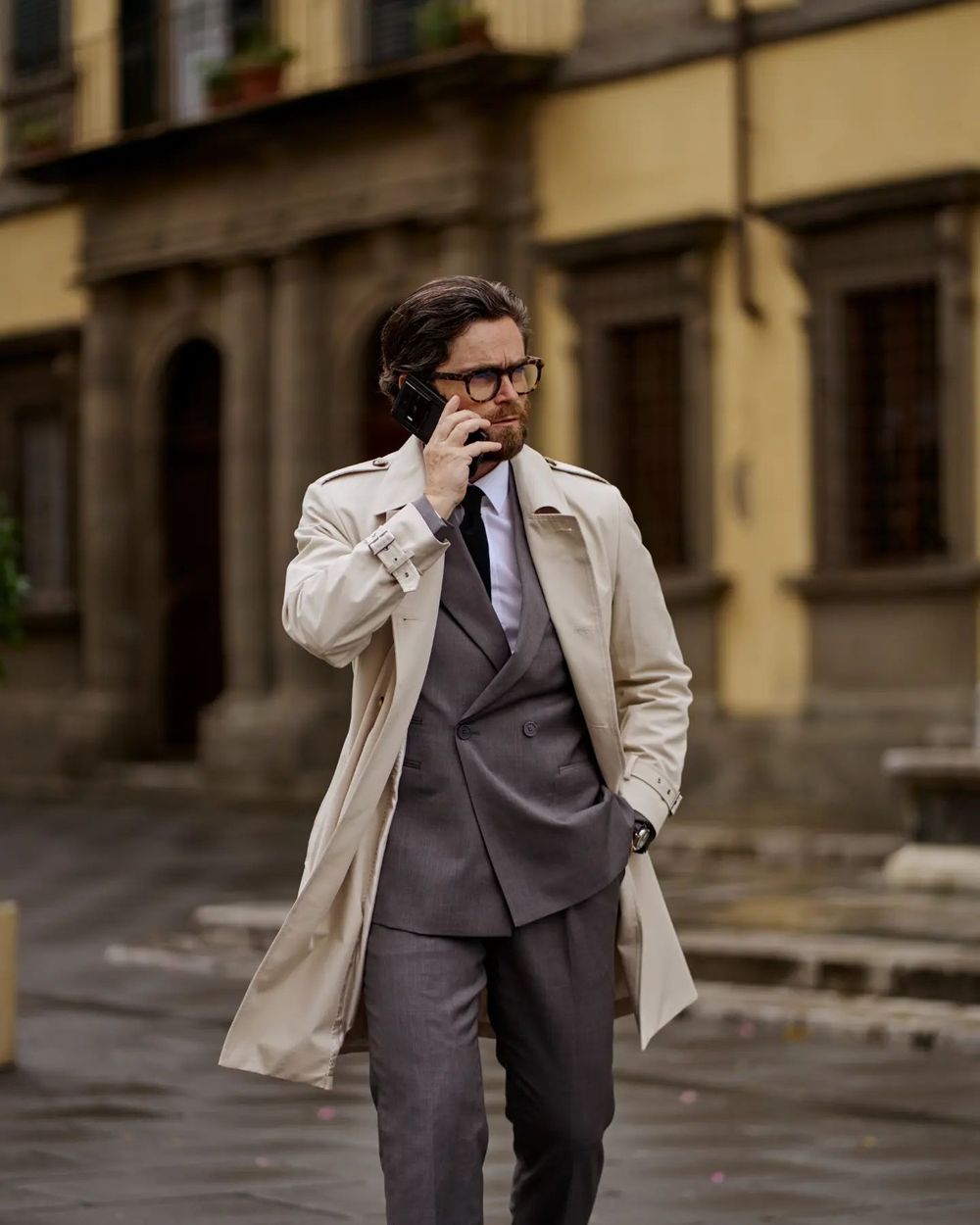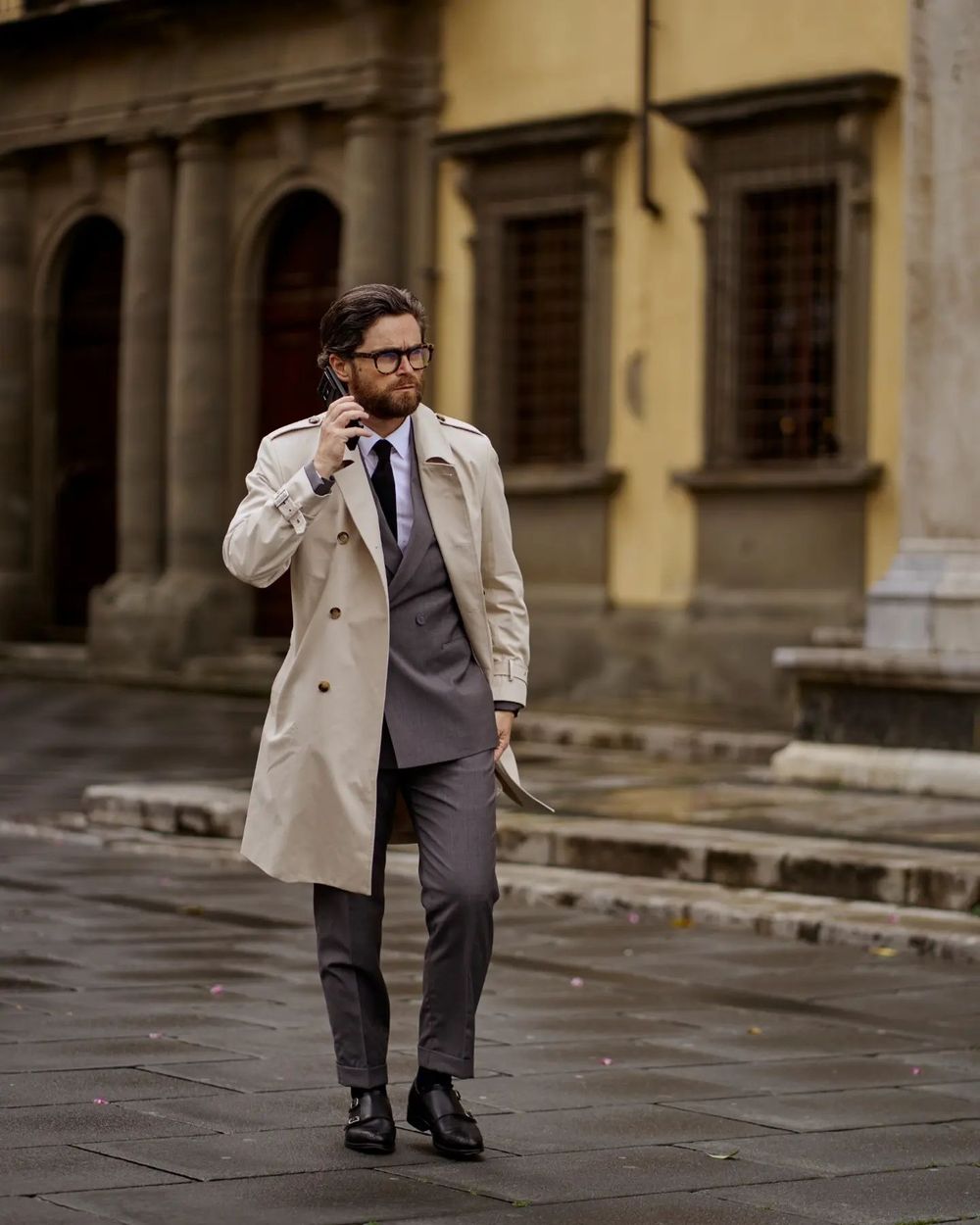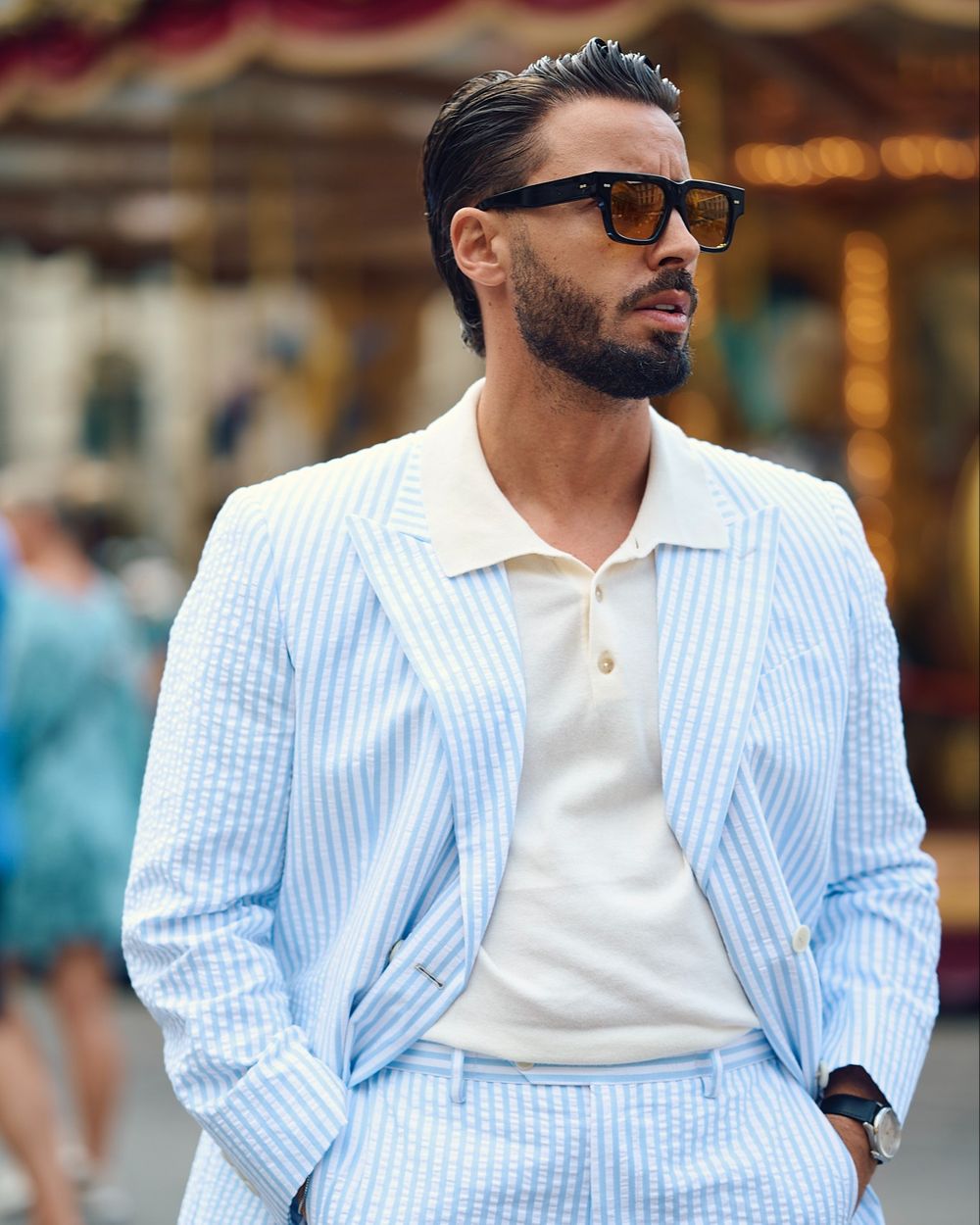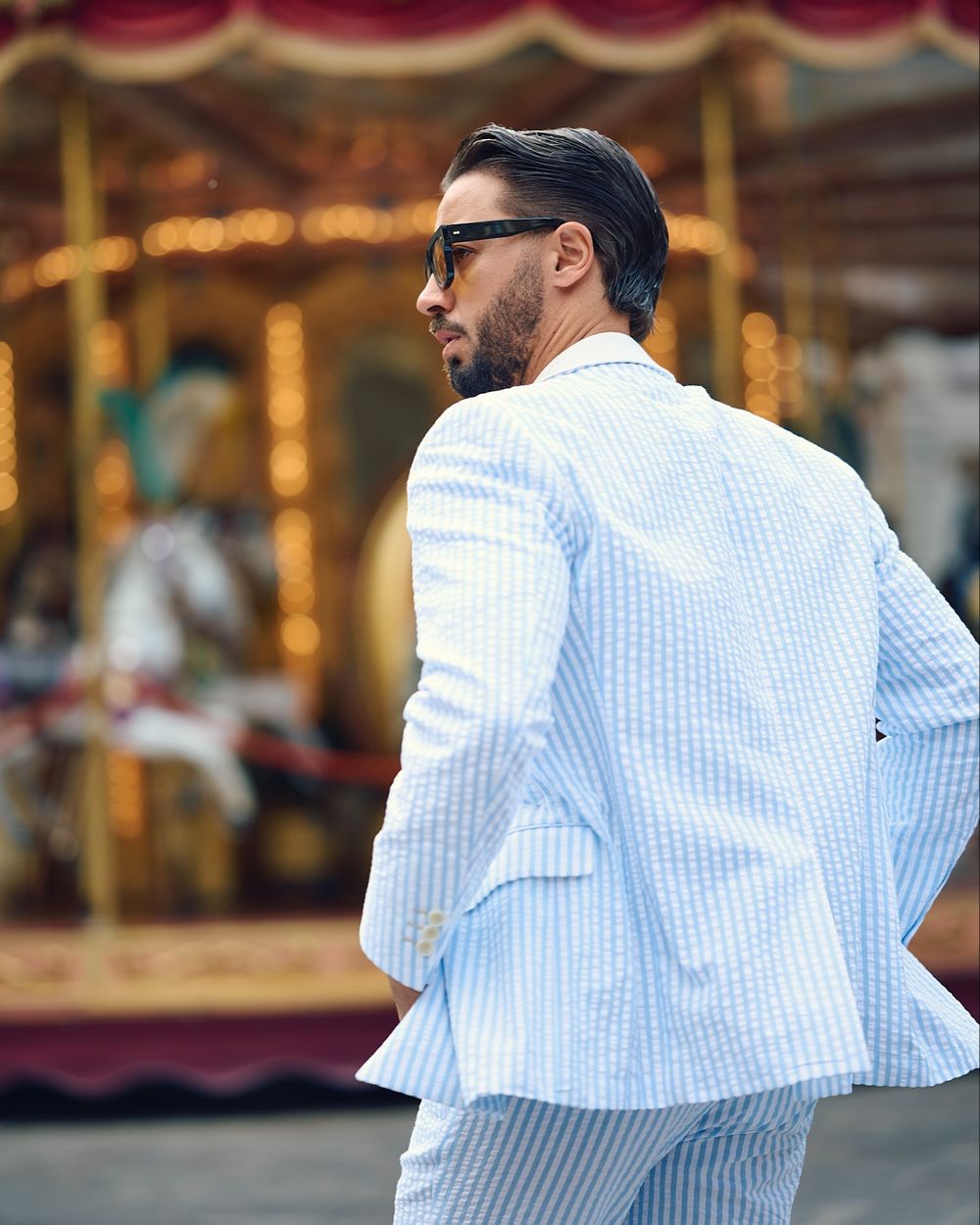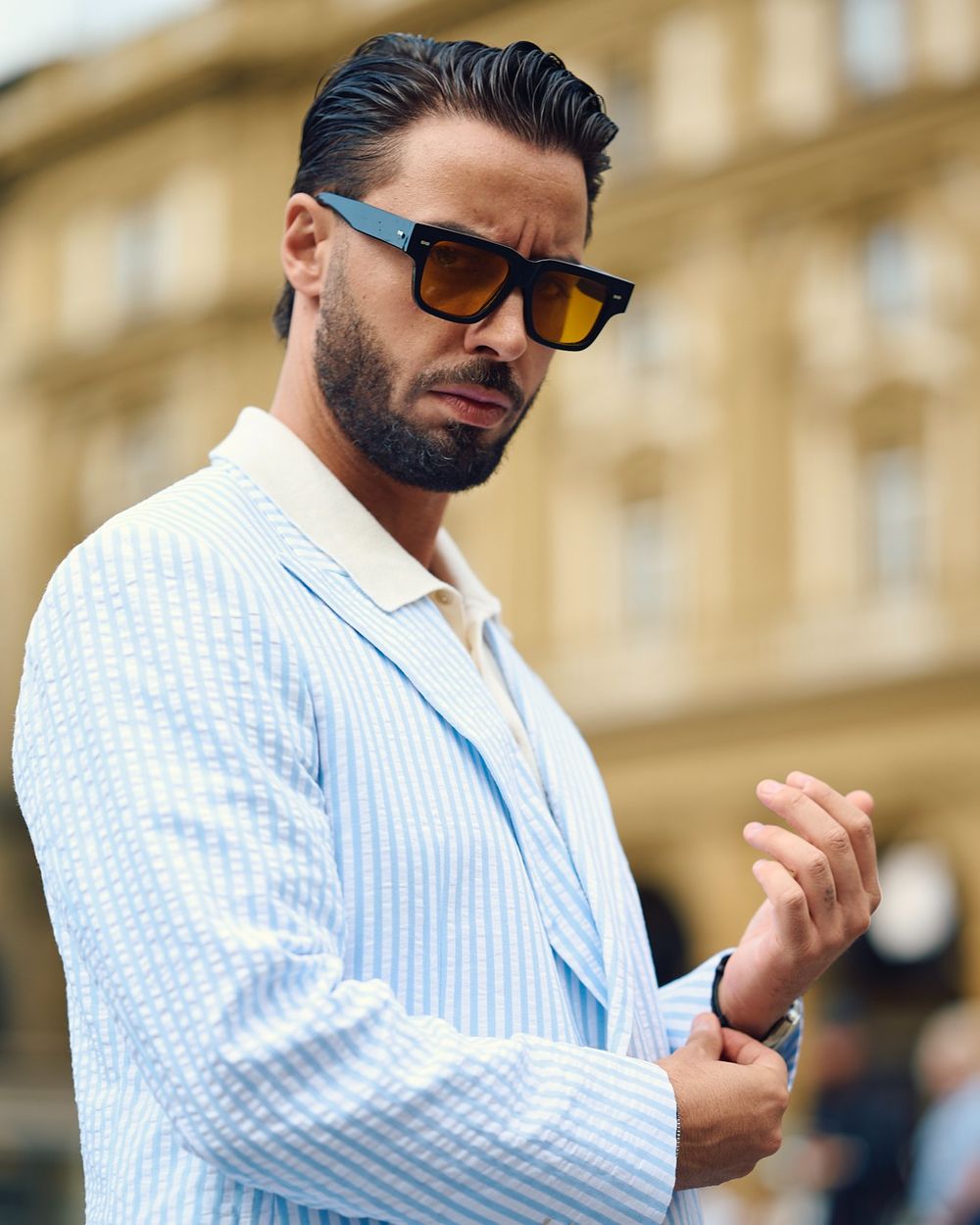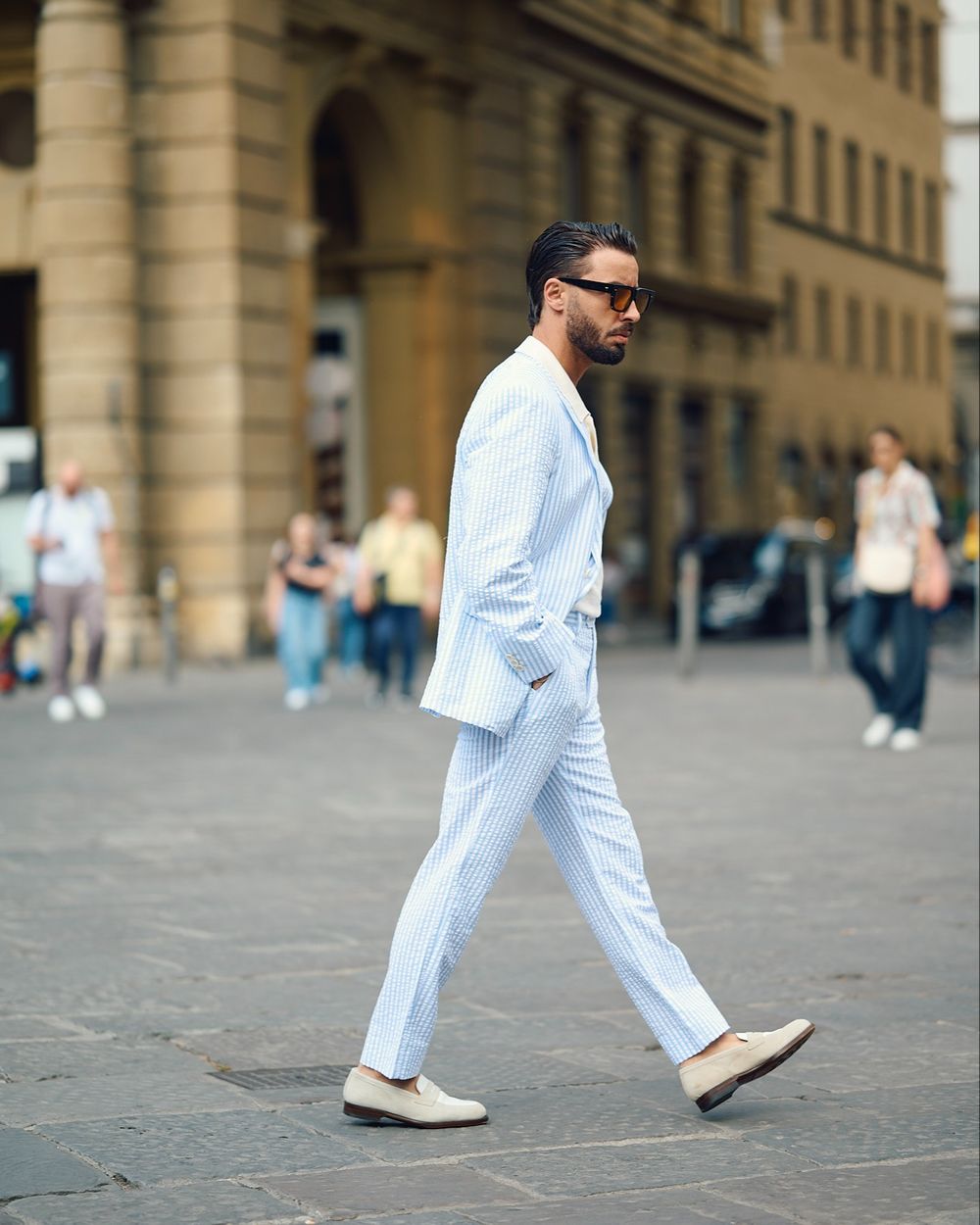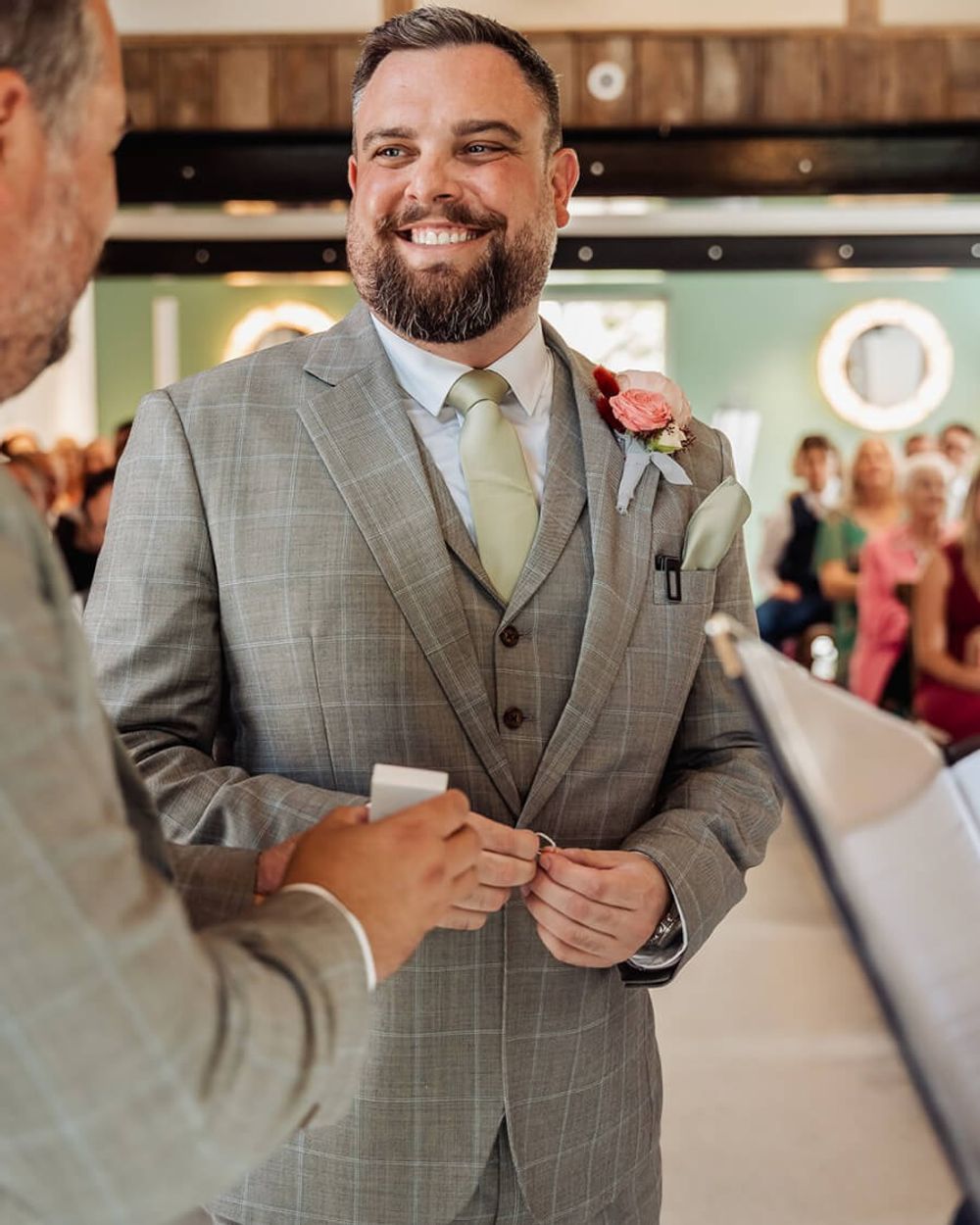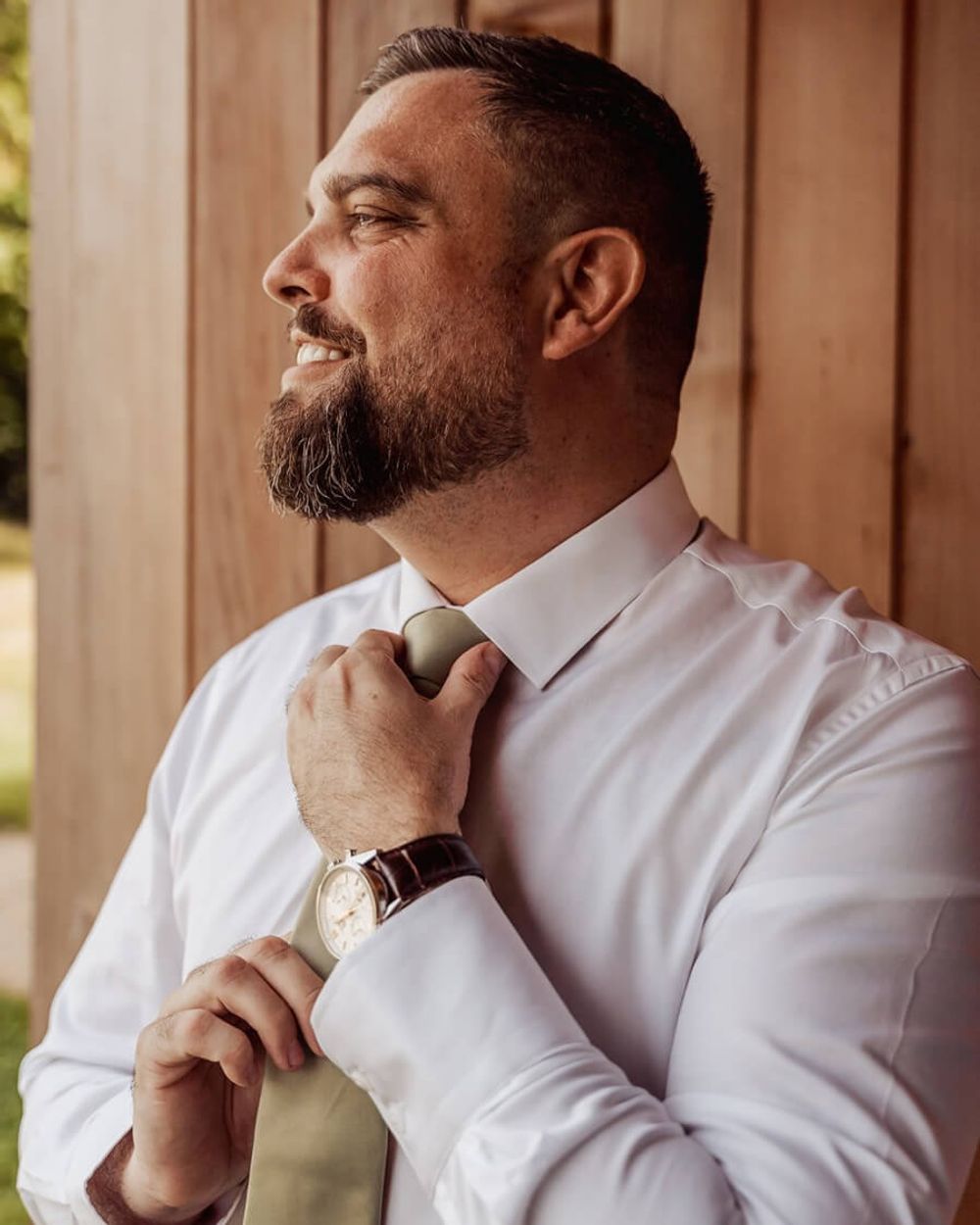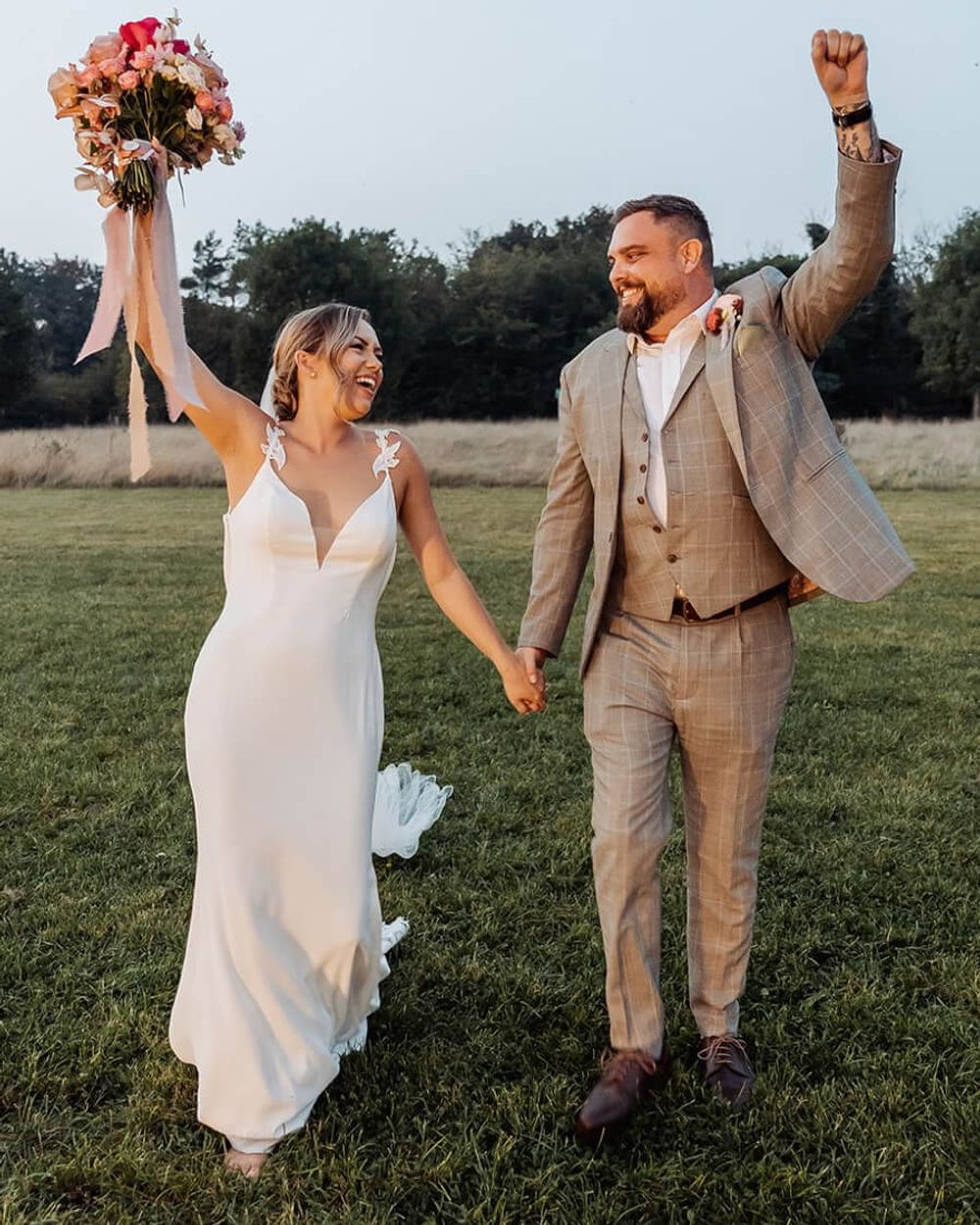A suit is the cornerstone of a man's wardrobe, not just a piece of clothing to put on. Through a long evolution, there are millions of suits out there today. Great, we have countless choices to dive in, but how can we know which is the right one for us when considering styles, fits, events and more? Everything will get easier as long as you know the basics.
That's why we introduce a list of the 31 most typical suit types you may see in daily life as well as special occasions, where they're best meant for. Once paired with the right dress shoes, ties and other accessories, suits instantly enhance your sleek look. Let’s go through one by one!
Suit Styles: Jacket Front Types
Before you start thinking about small details, let’s begin with the foundation of any suit: the front structure of its jacket. These two primary types determine both the overall formality and visual impression of the suit: single-breasted and double-breasted suits. Each has its own personality in your wardrobe.
1. Single-Breasted Suits
The single-breasted suit is the most versatile and widely worn jacket style. You’ll see single-breasted suits everywhere, from the office to, even, weddings. It's sleek, modern, and works on virtually every body type.
This style features a single row of buttons down the front and a narrow overlap of fabric when closed. It’s usually seen with one button; however, it can also come with a single row of up to 3 buttons. With this suit, it's important to know the golden rule: Always leave the last button unbuttoned if your blazer has more than one button. The fewer buttons the jacket has, the more casual the suit is.
- Features: Single row of buttons, up to 3 buttons max, can come with peak, notch, or shawl lapel.
- Effect: Slims down your waist, draws attention away from the stomach.
- Best for: Daily business wear, formal events, smart-casual style.

2. Double-Breasted Suits
The double-breasted suit appears with two parallel vertical rows of buttons, on either side of the blazer. Typically, this suit has 6 buttons; in rare cases, you can find it with 8 buttons. The minimum number of buttons is 4. Just like the single-breasted suit, it's essential to always leave the last button unbuttoned.
This suit is a dressier version, compared to the single-breasted suit, and more suitable for formal occasions. The overlapping fabric and button arrangement broaden the shoulders, slim the waist, and give a powerful silhouette, ideal for taller or athletic builds. It can also work for anyone who wants a sharper, more commanding look. That's always a bonus, ain't it?
- Features: Two parallel columns of buttons on either side of the jacket. It can come with 4, 6, or 8 buttons.
- Effect: Slimming, accentuates shoulders and height.
- Best for: Formal occasions, weddings, fashion-forward statements.

Discover more about How To Style A Double-breasted Suit
Double-Breasted Suits vs. Single-Breasted Suits: The Differences
Highlighting the difference between these two classic jacket styles, you can decide what suits both your body and your lifestyle. Our advice is that if you're just starting your suit collection, go single-breasted first. It's a timeless essential. If you're ready to experiment or need something for a dressier, fashion-forward look, try the double-breasted. 
| Category | Double-Breasted | Single-Breasted |
|---|---|---|
| Design | Two vertical rows (4–8 buttons) Overlapping front Often with peak lapels |
One vertical row (1–3 buttons) Narrow overlap Usually notch lapels |
| Fit Effect | Broadens shoulders, creates a V-shape | Slims waist, soft silhouette |
| Formality Level | Generally more formal | Versatile: Casual to formal |
| Body Type | Taller or athletic builds | All body types |
Suit Fits
Finding the right suit fit is like discovering your sartorial soulmate. The cut of your suit defines how it hugs your body, how it moves with you, and most importantly, how confident you feel wearing it.
3. Slim Fit Suits
As you may already know from the name, a slim-fit suit is close-fitting and hugs your body. Of course, the fit still offers room for movement and isn't as tight as you may think. This suit is narrower around the chest and shoulders, especially on the waist, and ends with a narrow-fitted leg. This sleek fit is great for men with a thinner build or a more athletic build, as it emphasizes your natural lines
- Features: Close-fitting, narrow around chest and shoulders, narrow legs.
- Effect: Slimming, accentuates natural body shape.
- Best for: Business, weddings, dates, evening events.
4. Regular Fit Suits
Also known as the classic fit, this is the most traditional suit option. It provides the perfect amount of comfort, especially around the chest and shoulders. The jacket is only slightly fitted and reaches the hips, with straight-leg trousers.
This suit provides maximum comfort without looking baggy. It’s timeless and reliable, especially for men who prefer a relaxed but still refined appearance. If you’re unsure where to start, a regular fit suit in navy or charcoal is your safest bet.
- Features: Relaxed fit, mid-length jacket, bootcut pants.
- Effect: Hugs natural body shape, relaxed appearance.
- Best for: Corporate settings, interviews, day-to-day wear.
5. Modern Fit Suits
A modern fitted suit shares a few similarities with the slim fit. Even though it has a close fit, it is slightly more relaxed than a slim fit, which makes it far more versatile. In fact, we could call this kind of fit a hybrid of a regular and slim fit.
-
- Features: Close fit with more room than slim fit, combining elements of regular and slim fit.
- Effect: Versatile, accommodating a wider range of body types.
- Best for: Office wear, semi-formal events, travel.

Gray Windowpane Double-Breasted Suit
Suit Lapels
Lapels are like the eyebrows of a suit jacket; they frame your upper body and set the tone for the overall style. Here are three major suit types categorized by lapels you’ll encounter.
6. Peak Lapel
The peak lapel is a dramatic V-shaped tip lapel, pointing upwards towards the shoulders. It’s often found on double-breasted jackets or high-end formalwear, worn by many celebrities on the red carpet. If you are someone with a more rounded facial shape, then this lapel is a great choice. The sharp element of the lapel will balance out the round elements of your face shape well, creating perfect harmony.
- Features: Dramatic V-shaped tip pointing upwards.
- Effect: Balances rounded facial shapes and enhances shoulder width.
- Best for: Formal events, business power suits.

Discover Three-piece Wedding Suits
7. Notch Lapel
The notch lapel is a milder version of the peak lapel and is typically seen on most suits. This lapel meets the collar of the jacket at a 75–90° angle and has a much softer edge compared to the peak lapel.
If you're seeking something more flexible, then we suggest you go with the notch. Its subtle shape complements most face types and jacket styles.
- Features: Meets the collar at a 75 to 90-degree angle, softer edge compared to peak lapel.
- Effect: Clean and understated.
- Best for: Suits a wide range of occasions and face shapes.

8. Shawl Lapel
The shawl lapel is instantly recognizable thanks to its smooth, rounded edge with no break or notch. This kind of lapel has more limited use than the rest and is mainly reserved for black-tie events. Hence, they make a good option for tuxedos.
The shawl lapel is considered the most formal lapel, exuding classic sophistication and a sense of luxury. Because of its soft elements, this lapel is perfect for men with sharp features and is often paired with satin or velvet.
- Features: Rounded, continuous fabric around the collar, typically for formal wear.
- Effect: Softens sharp facial features, adds elegance to formal attire.
- Best for: Black-tie events, galas, weddings.
Suit Fabrics
The material of a suit plays a major role in how it feels, breathes, and drapes on the body. Depending on seasons, occasions or personal preferences, we have various options of fabrics to choose the right suit.
9. Wool
Wool is the king of all suiting fabrics. There are so many benefits that wool offers: durability, wrinkle resistance, water resistance, breathability, etc. If you're willing to invest in a high-quality suit, then we suggest you go for a wool suit. Not only will this suit last for decades, but it will offer you the comfort you need, releasing the stress you suffer during work days!
Wool suits are a year-round favorite, but we especially recommend them for winter. After all, wool is a great heat insulator.
- Features: Durable, wrinkle, water-resistant, breathable; adaptable all-arounder.
- Effect: Versatile, smooth texture, timeless elegance.
- Best for: Everyday wear, business suits, formal occasions.
10. Tweed
Tweed is a thick, rugged woolen fabric with a distinct texture and often a herringbone or checked pattern. This fabric is perfect for colder months or rainy days, offering warmth and weather resistance.
It’s commonly seen in fall and winter wardrobes and has an intellectual, vintage flair.
- Features: Tightly woven dyed wool, water-repellent, thick and coarse.
- Effect: Warm, heavier feel, textured appearance, heritage charm.
- Best for: Autumn/winter, countryside weddings, creative professionals.
11. Cotton
After wool, cotton is the second most used fabric for suits. Although cotton suits tend to be a better option for the summer than winter, due to their lightweight properties and breathability. Some other benefits include its hypoallergenic properties and odor-free properties, perfect for sweaty days!
The only disadvantage of a cotton suit is that it does wrinkle more easily and is prone to damage, as it's made up of organic material. So be aware of how you wash your cotton suit and take good care.
- Features: Lightweight, breathable, hypoallergenic.
- Effect: Clean, slightly rigid structure, casual elegance.
- Best for: Summer events, business casual, smart weekend wear.
12. Linen
Linen suits are the epitome of summer sophistication. Made from flax plant fibers, linen is breathable, soft, and absorbs moisture better than cotton.
Although linen wrinkles, that’s also part of its charm. Linen lets your skin breathe comfortably, giving off a breezy, resort-inspired look that’s perfect for warm destinations or beach weddings.
- Features: Durable, moisture-protective, soft, hypoallergenic.
- Effect: Airy, lightweight, natural wrinkles and laid-back comfort.
- Best for: Hot weather, destination weddings, resort style.
13. Velvet
Velvet is the fabric of luxury. With its soft pile and rich sheen, it exudes sophistication and bold character. Though less common, it makes a statement whenever it appears.
The unique feature of velvet is that it catches light in a way few other fabrics do. It’s most often used for dinner jackets or tuxedos and should be worn with confidence.
- Features: Warm, soft, catches light; less common fabric.
- Effect: Eye-catching, opulent, vintage-inspired.
- Best for: Evening events, cocktail parties, New Year’s Eve, fashion-forward weddings.

Suit Vents
Suit vents may seem like a small detail, but they have a big impact on comfort, movement, and style. Vents are slits at the back of your jacket that allow it to open slightly, riginally designed for horseback riding, but today they shape how your jacket flows with your body.
14. Center Vent
The center vent, also known as a single vent, is a straight vertical slit at the middle of the back hem of the jacket. It has been a staple of American tailoring since the mid-20th century, offering simplicity and ease of wear.
This type of vent allows room to move and sit comfortably. Note that when placing your hands in your pocket, the vent can slightly pull apart and expose a part of your back.
- Features: Single vent cut in the middle of the jacket.
- Effect: Comfortable and traditional, allows space for movement.
- Best for: Casual and business wear.

15. Double Vent
Double vents feature two slits on either side of the jacket’s back. The double vent originally came from Europe and is often viewed as a more sophisticated piece. Not only does it take more time and money to produce, but it also allows for a slimmer torso. If you're a man who loves class and style, then go for the double vent.
- Features: Two vents on the back side of the hem.
- Effect: Sophisticated, tailored look, allows for a slimmer torso appearance.
- Best for: Business suits with European cuts.

16. Ventless Suits
The most stylish of all - the ventless suit. Ventless jackets have no slits at the back, offering the cleanest, most minimalist silhouette. This style is typically reserved for special black-tie events and very formal eveningwear.
Although this blazer is great at outlining your figure, it comes with a big disadvantage: Sitting or placing your hands in your pockets will crease the jacket, which may make you uncomfortable.
- Features: No vents, often seen on tuxedos.
- Effect: Sleek silhouette, but restricts movement.
- Best for: Black-tie events, dinner jackets, formalwear.
Suit Pockets
While you may never use pockets for storage, the type of pocket says a lot about the formality and character. Get ready to explore the four most common suit styles based on pockets and how to use them to your advantage.
17. Patched Pocket
The patched pocket is the most casual and relaxed of all pocket types. It’s sewn directly onto the outside of the jacket and made of the same material as the blazer, often rectangular. The patch pocket is best for sports coats and is a great space to keep your phone, keys, or other small items.
Patched pockets create a less structured appearance, making them perfect for unstructured or semi-formal suits.
- Features: External pockets on the jacket, casual look.
- Effect: Practical, adds a relaxed touch to the suit.
- Best for: Casual to smart-casual outfits.

18. Flap Pocket
Flap pockets are smaller than patched pockets and less noticeable. A rectangular flap of fabric covers the pocket opening, adding a touch of polish while remaining practical. Just like the patched pocket, the flap pocket is made from the same fabric.
Although flap pockets are considered to be more formal, they can be seen on both business suits and on sports coats. If you can't decide on a pocket, the flap is the standard choice of all of them and may be the best option for you (except for black-tie events).
- Features: Small, less noticeable pockets with a rectangular flap.
- Effect: Clean, classic, and slightly formal.
- Best for: Office suits, interviews, and general versatility.

19. Jetted Pocket
Jetted pockets, also called a besom pocket, is sewn into the jacket lining with only a slim horizontal slit visible. Basically, they are similar to flap pockets, only that they have no flap. Overall, its style is much more minimalistic and clean, which makes it the ideal pocket for formal clothing, such as tuxedos or dinner jackets.
- Features: Similar to flap pockets but without the flap, minimalistic.
- Effect: Ultra-clean silhouette, no visual interruption.
- Best for: Black-tie events, formal occasions.
20. Welted Pocket
The welted pocket is usually found on the chest area of a suit jacket. It’s the pocket where you’d tuck a pocket square. It has a narrow reinforced edge, called a "welt", and is typically sewn using the same fabric as the jacket.
- Features: Typically the breast pocket, same fabric as the jacket.
- Effect: Frames your chest and draws the eye upward
- Best for: All suits and occasions.

Suit Button Configurations
The number and position of buttons influence how a suit frames your torso, affects its balance, and even impacts posture.
21. One-Button Suits
This is the most casual option for the jacket and allows space for movement. With just a single button at the waist, it offers a deep V-cut that creates a modern, elegant look. Moreover, a single-button suit creates a slimming effect on your shoulders and balances a wide peak lapel. This suit is perfect for smaller men, as the one-button jacket will expose your shirt and tie, which will create the illusion of being taller.
- Features: Single button on the jacket, casual style.
- Effect: Creates a slimming effect, suitable for shorter men.
- Best for: Evening events, cocktail parties, fashion-forward looks.
22. Two-Button Suits
The two-button jacket is probably the most classic suit you can find today. This is the perfect modern business suit for those who are looking for something more versatile and wearable for more occasions. It offers a balanced frame, slight waist suppression, and a medium V-shape that works for most body types.
- Features: Two buttons, versatile.
- Effect: Traditional yet modern, flattering for most body types.
- Best for: Office wear, weddings, day-to-day suiting.

23. Three-Button Suits
The three-button suit is more formal and structured, offering a higher button stance. The number of buttons creates a shallower V cut and has shorter lapels, making it suitable for taller and athletic individuals or anyone wanting a slightly vintage flair.
- Features: Three buttons, shallower V-cut, shorter lapels.
- Effect: Suitable for taller or athletic body types, a formal appearance.
- Best for: Traditional settings.
Suit Buttoning Rules
- Two or three-button suits should always have their last button undone. You're curious as to why? Well, it's simply a trend that began back in England in the early 1900s, during King Edward VII's reign. You can read more about it in our blog post Suit Buttons: Everything You Need to Know.
- Rule number two: Always undo all of your buttons when sitting. No matter if you're wearing a two-button suit or a three-button suit, the entire row should always be unbuttoned. This will prevent the jacket from stretching awkwardly across your back.
Suit Canvas Construction
The canvas is one of the most overlooked elements in a suit, but it’s absolutely essential. It’s the inner layer between the outer fabric and the inner lining that helps the suit drape properly and hold its shape over time. Canvas affects everything from structure to movement to long-term durability.
24. Full Canvas
A full canvas starts at the chest area of the jacket (including the lapel) and flows throughout the jacket to the hem. Although this option is pricier, a full canvas allows the suit to drape amazingly well, giving you a truly custom-like fit. Moreover, the durability of the suit, mostly around the stress points such as the shoulder and elbows, can be improved.
- Features: Canvas from chest to hem, durable, excellent drape.
- Effect: Superior fit and longevity, adapts to body shape over time.
- Best for: Premium formalwear for high-class events.
25. Half Canvas
Just like a full canvas, a half canvas starts at the shoulders but only reaches halfway through the jacket. The piece is sewn into the chest and lapel of the jacket. It's certainly a more affordable and lightweight option and still offers definition. However, it will not have the benefits of a fully fitted suit, which is found within the full canvas.
- Features: Canvas from shoulder to mid-jacket.
- Effect: Structured chest with a softer lower half.
- Best for: Business environments, weddings (for grooms).

26. Fused Suits
A fused canvas suit simply has an interlining glued to the fabric of the suit instead of sewn canvas, commonly found in off-the-rack suits. They’re fast to produce and cost-effective, but may not last as long. Keep in mind, the fit of a fused suit is not as good as that of a canvas suit, nor will it be as durable, as the glue will dry over the years.
- Features: Interlining glued to fabric, economical.
- Effect: Clean but stiff drape, less breathable.
- Best for: Occasional wear, budget-conscious shoppers.

Other Special Types of Suits
Now that we've covered structural and styling fundamentals, let’s explore some specialized suits that break the rules or serve unique purposes. These types bring cultural significance, elevated formality, or a twist of personality into the mix.
27. Three-Piece Suits
Let’s start the section with a classic suit type, going together with an additional piece. A three-piece suit actually just includes a matching vest (waistcoat) alongside the jacket and trousers (without a vest, we call it a two-piece suit)
This suit offers a more formal, layered look. The vest keeps your look polished even when you remove the jacket.
- Features: 3 pieces including jacket, waistcoat, trousers.
- Effect: Adds formality and vertical lines that elongate the torso.
- Best for: Weddings, formal business events, chilly seasons.

28. Tuxedos
A tuxedo is the go-to formal suit for black-tie occasions. Its defining feature? The use of satin or grosgrain on the lapels, buttons, and pant side-stripes. They come in single-breasted and double-breasted styles and should be worn with a formal dress shirt, patent leather shoes, cufflinks, a cummerbund or a low-cut waistcoat.
- Feature: Satin lapels (usually shawl or peak), covered buttons, worn with a bow tie
- Effect: Adds formality and vertical lines that elongate the torso.
- Best for: Weddings, galas, formal business events.

29. Morning Suits
The morning suit is traditional British daytime formalwear, instantly recognizable by its long tailcoat, worn with striped trousers and usually a contrasting waistcoat. This is the outfit of royalty, traditionally paired with a tie.
The morning suit can come with different waistcoat options like single-breasted, double-breasted, or even a more informal slip-over.
- Features: Morning coat, waistcoat, striped trousers, tie.
- Effect: Stately, elegant, and steeped in tradition.
- Best for: Formal daytime weddings, royal events, horse races, cultural ceremonies.

30. Mandarin / Collarless Suits
The mandarin suit, sometimes called a band collar or collarless suit, features a short, upright collar with no lapels. It draws inspiration from traditional Chinese garments, blended with modern tailoring, offering a minimalist, bold look.
The primary variation of mandarin suits is in the material, with some made of luxurious silk while others might be of more standard suit fabrics.
- Features: Upright band-like collar that does not fold over.
- Effect: Sleek and unconventional, draws attention upward.
- Best for: Semi-formal events, cultural occasions, creative professionals.

31. Nehru Suits
Named after India’s first Prime Minister, Jawaharlal Nehru, the Nehru suit is similar to the mandarin style but often comes with a longer jacket and more ornate finishes. The Nehru suit blends cultural heritage with contemporary formality and has gained popularity globally for evening receptions and formal events.
- Features: Similar to the Mandarin suit, decorative buttons, rich fabrics and sometimes embroidery.
- Effect: Sophisticated and distinctive, with a tailored longline shape.
- Best for: Cultural celebrations, formal dinners, destination weddings.
The Summary of 31 Suit Types
| Category | Suit Type | Characteristics |
|---|---|---|
| Jacket Front | Single-Breasted Suit | One column of buttons, versatile, classic style |
| Double-Breasted Suit | Two columns of buttons, more formal and structured | |
| Fit | Slim Fit Suit | Close-fitting, sharp silhouette, best for lean or athletic builds |
| Regular Fit Suit | Balanced cut, classic comfort, suits most body types | |
| Modern Fit Suit | In-between slim and regular, tailored look with room to move | |
| Lapels | Notch Lapel | Most common, versatile, used in business and casual suits |
| Peak Lapel | Formal and bold, pointed upward, seen in tuxedos and power suits | |
| Shawl Lapel | Rounded edge, often found in tuxedos, smooth and elegant | |
| Fabrics | Wool | All-season fabric, breathable, durable, and wrinkle-resistant |
| Tweed | Rough woolen fabric, ideal for colder months, vintage look | |
| Cotton | Lightweight, breathable, more casual look | |
| Linen | Very breathable, ideal for summer, wrinkles easily | |
| Velvet | Luxurious, soft, best for evening and formal wear | |
| Vents | Center Vent | Single slit at back, common in American‑style suits |
| Double Vent | Two side slits, allows more movement and shape | |
| Ventless Suit | No slits, sleek look, common in Italian tailoring | |
| Pockets | Patched Pocket | Casual style, pockets sewn on the outside of the jacket |
| Flap Pocket | Classic pocket with flap cover, versatile | |
| Jetted Pocket | Sleek, no flap, formal and minimalist | |
| Welted Pocket | Mostly on vests, narrow opening, minimal bulk | |
| Buttons | One-Button Suit | Modern and sleek, best for evening wear |
| Two-Button Suit | Most versatile, flatters most body types | |
| Three-Button Suit | Classic, slightly old-fashioned, for taller men | |
| Canvas | Full Canvas | The entire front has sewn canvas, superior drape and durability |
| Half Canvas | Canvas in upper half only, balance of quality and cost | |
| Fused Suit | Glued interlining, affordable, less breathable | |
| Special | Three-Piece Suit | Includes a vest, adds formality and layering |
| Tuxedo | Formal evening wear with satin lapels and side stripes | |
| Morning Suit | Formal daytime wear with a tailcoat, often striped trousers | |
| Mandarin / Collarless Suit | No lapel, upright collar, modern or cultural events | |
| Nehru Suit | Indian‑inspired, long jacket with band collar |
Choosing the Right Suit Based on the Occasion
So, we listed all popular types of suits for men above, along with the appropriate occasions to wear them. However, I will still share with you tips on choosing suitable suits for various events that everyone can attend and experience. Through that, you will be able to style a suit outfit that expresses your own personality.
Beach Wedding
Embrace the seaside ambiance in a breezy, sun-kissed linen suit that whispers laid-back elegance. Heavy fabrics and dark shades are mere party poopers here, where the ocean breeze demands lightness and grace.
- Standard Choice: Linen suit (light colors like beige, light blue, or grey).
- Optional: Lightweight cotton suit.
- No-go: Heavy wool suits, double-breasted suits.
Corporate Business Meeting
In the realm of high stakes and firm handshakes, a sharp, meticulously tailored single-breasted suit speaks volumes. Opt for understated sophistication in navy or charcoal - loud patterns and casual attire need not apply.

- Standard Choice: Single-breasted suit (navy, charcoal, or black).
- Optional: Three-piece suit for added formality.
- No-go: Bold colors or patterns, casual fabrics like linen or cotton.
Cocktail Party
As twilight beckons, slip into a sleek, slim-fit suit, with a touch of midnight velvet if you dare. This is where sophistication meets fun, leaving the tuxedo for more ceremonious affairs and the linens for sunnier days.
- Standard Choice: Slim-fit suit in darker colors.
- Optional: Velvet blazer for a touch of luxury.
- No-go: Tuxedos (too formal), overly casual suits (e.g., linen).
Job Interview
First impressions are paramount, so don a polished, classic suit in navy or charcoal. It's the armor for success, where pinstripes can whisper ambition, but flashy colors scream caution.
- Standard Choice: Classic fit suit (navy or charcoal).
- Optional: Subtle patterned suit (like pinstripes).
- No-go: Flashy colors, casual suits.
Black Tie Event
A time-honored tuxedo becomes your ticket to a world of glamour and sophistication. It's where the classic reigns supreme, sidelining the everyday business suit for a dance with timeless elegance.

Classic Black Tuxedo with Bow Tie
- Standard Choice: Tuxedo.
- Optional: Dinner jacket with black trousers.
- No-go: Business suits, light-colored suits.
Outdoor Summer Event
Navigate the heat with feather-light linen or cotton, a sartorial oasis in the scorching summer. Dark, heat-absorbing colors and heavy wools are banished, for comfort reigns supreme under the sun.
- Standard Choice: Lightweight linen or cotton suit.
- Optional: Seersucker suit.
- No-go: Heavy wool suits, dark colors that absorb heat.
Winter Formal Event
Wrap yourself in the warm embrace of a cozy, heavier wool suit, where tweed can add a dash of character. The chill commands respect for warmth, leaving behind the whispers of linen and the hues of summer.

- Standard Choice: Wool Suit (heavier weight).
- Optional: Tweed Suit for added texture.
- No-go: Light fabrics like linen, Light colors.
Casual Business Environment
Stride through the office in a relaxed fit suit, a nod to professionalism with a whisper of ease. Here, the tuxedo is too grand, and the three-piece suit too stern, for the language of casual business speaks in softer tones.

- Standard Choice: relaxed fit suit (subtle colors).
- Optional: Blazer with chinos or dress pants.
- No-go: Tuxedos, very formal three-piece suits.
Gallery Opening or Creative Event
Let your ensemble be your canvas at a creative soirée, with a modern fit suit in unique hues or patterns. Traditional business attire fades into the background, making way for expressions of individuality and flair.

- Standard Choice: Modern fit suit with a unique color or pattern.
- Optional: Stylish blazer with smart-casual trousers.
- No-go: Overly formal suits, traditional business suits.
Day at the Races
Stand out in the grandstand in a dapper morning suit or a tastefully classic ensemble, accented with a bold tie or pocket square. Casual wear and unstructured suits are left at the gate, for this is a parade of finesse and tradition.
- Standard Choice: Morning suit (if very formal) or classic suit.
- Optional: Bold tie or pocket square.
- No-go: Casual wear, unstructured suits.
Date Night
Charm your evening in a soft-shouldered Italian suit, where casual meets chic. It's the perfect blend for romance under the stars, leaving the stiff formals for boardroom battles and tuxedos for the ballroom.

- Standard Choice: Casual suit (like a soft shoulder Italian suit).
- Optional: Stylish sports coat with jeans for a more relaxed look.
- No-go: Overly formal business suits, tuxedos.
Graduation Ceremony
Mark the milestone in a smart, modern fit suit, a beacon of your journey ahead. The day calls for a balance between formal and casual, leaving behind the extremes for a celebration of achievement.

- Standard Choice: Slim or modern fit suit (navy, grey) or tuxedo. Check our prom suits.
- Optional: Blazer and dress trousers.
- No-go: Very casual or overly formal attire.
Religious Ceremony
Step into the sacred with a timeless, conservative suit, where respect and tradition weave through every thread. It's a moment for understated elegance, setting aside the flamboyance for a serene homage to solemnity.

- Standard Choice: Conservative suit (classic colors like navy or grey).
- Optional: Three-piece suit for added formality.
- No-go: Flashy colors, casual suits.
Networking Event
Navigate the mingle with a business-casual ensemble, smart yet approachable. It's the dance of professionalism with a hint of ease, where full formal suits and casual flair watch from the sidelines.
- Standard Choice: Business casual suit (not too formal).
- Optional: Smar blazer and dress pants.
- No-go: Full formal suits, Casual or flashy attire.
Final Tips:
- Always prioritize comfort. No matter how good a suit looks, if you're not comfortable, it's not the right one.
- Ensure you have the basics first, like a classic navy or charcoal suit, before venturing into more unique options.
- Always get your suits tailored, even off-the-rack ones, for that perfect fit.
Questions to Consider When Choosing A Suit
Generally, not just for occasions, you can determine the suit style that you need by answering the following questions. They are just the summary of all types we've discovered, but going through each factor like this helps you imagine (and of course, own) the perfect suit more easily without any regret!
1. What's the Occasion?
- Formal or Black-Tie Events: Consider a tuxedo or morning suit.
- Business/Work: Go for a business suit in conservative colors. Single-breasted suits with notch lapels are popular. Learn how to rule your business attire with Harvey Specter.
- Casual Outing: Casual suits or lounge suits are apt. Linen or cotton suits work well for a relaxed look.
- Travel: Travel suits, wrinkle-resistant and functional, are your best friends.
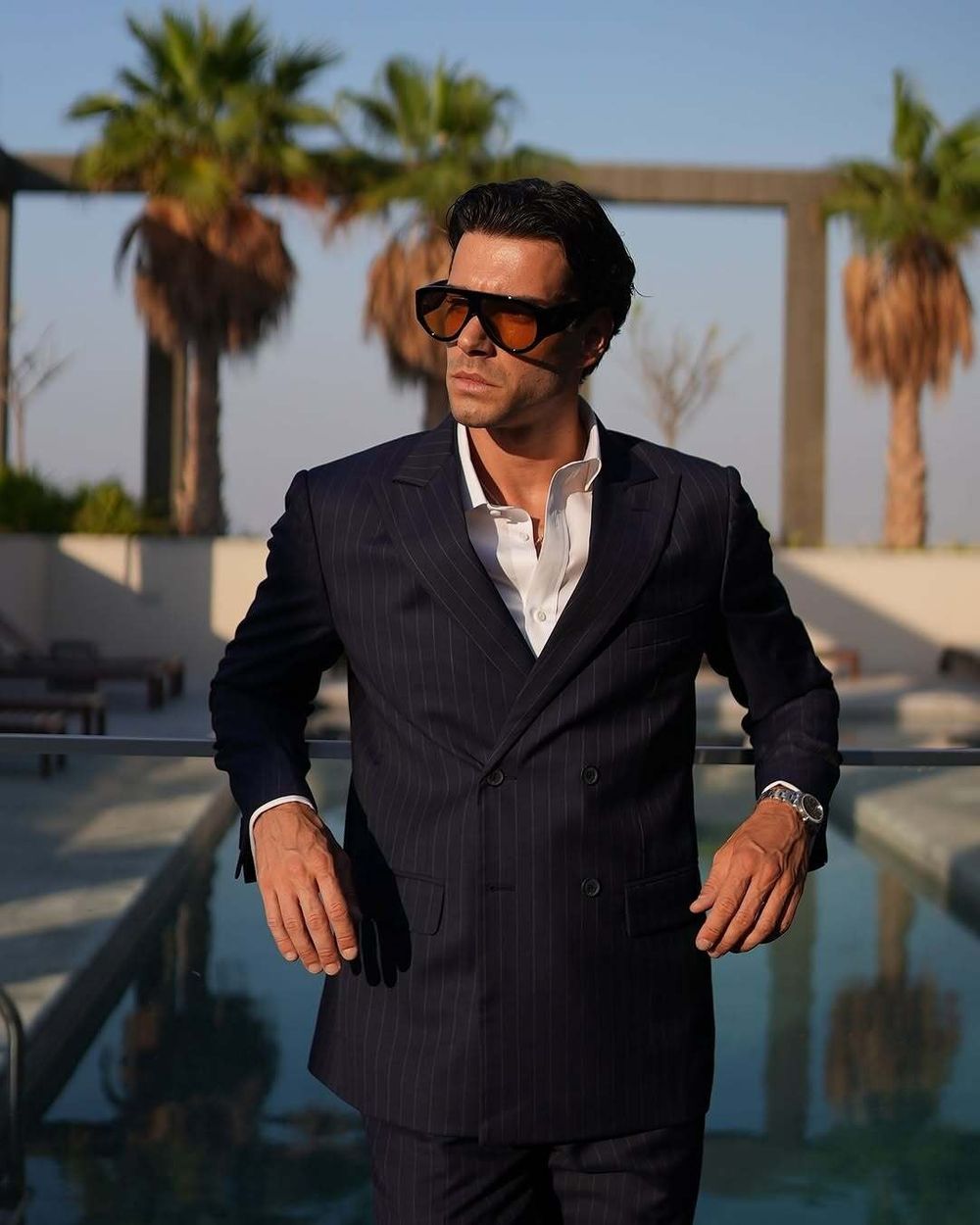
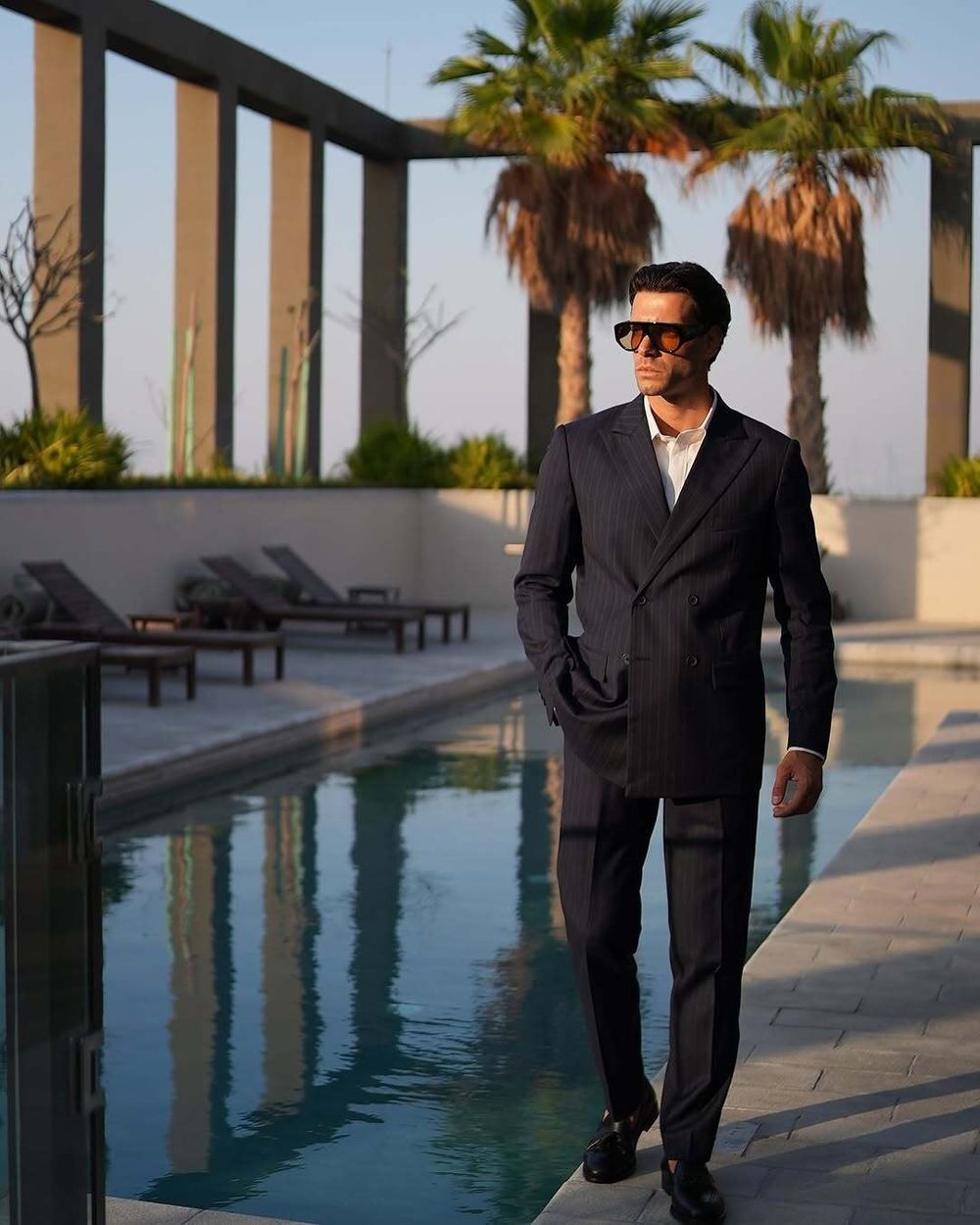
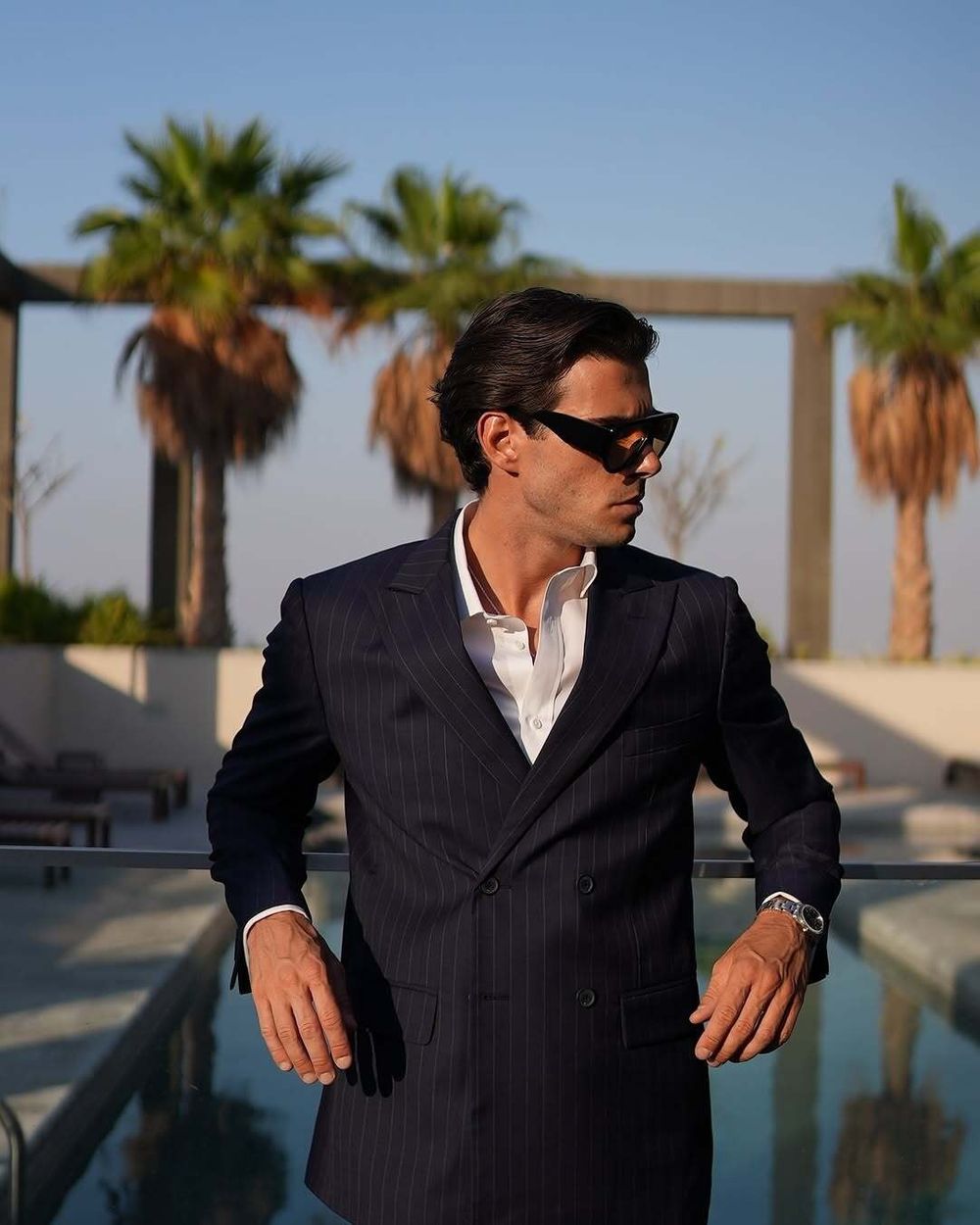
2. Which Region's Style Appeals to You?
- Elegant and Slim: Italian suit.
- Classic and Refined: British suit.
- Comfortable and Practical: American suit.
Curious about European vs American style? Check our post.
3. How Do You Prefer the Suit to Fit?
- Close to the Body: Slim Fit.
- Traditional Silhouette: Classic Fit.
- Balanced: Modern Fit.
- Roomy and Comfortable: Relaxed Fit.
4. What's Your Climate or Season?
- Warm and Humid: Summer Suit in light fabrics like linen or lightweight cotton.
- Cold and Chilly: Winter Suit made of wools or blends.
5. Which Fabric Appeals to You?
- Soft and Luxurious: Wool varieties like Merino, Cashmere, or blends.
- Light and Airy: Cotton or Linen.
- Shiny and Unique: Velvet or Silk.
- Budget-friendly: Synthetic materials or blends.
6. How Much Are You Willing to Invest?
- Budget-Friendly: Off-the-Rack.
- Mid-Range with Personalized Fit: Made-to-Measure.
- High-End Customization: Bespoke.
Check out our Suit Brands article to learn more about the price ranges of suits available on the market.
7. How Do You Like Your Jacket Detailed?
- Buttons: One for a modern look, two for versatility, three for tradition, and four for a unique stance.
- Lapels: Notch for every day, Peak for formality, Shawl for tuxedos.
- Vents: None for a clean look, Center for tradition, Side Vents for easy movement.
8. How About Those Trousers?
- Clean Line: Flat Front.
- Traditional Look: Pleated.
- Finishing Touch: Decide between Cuffed vs. Non-Cuffed based on style preference.
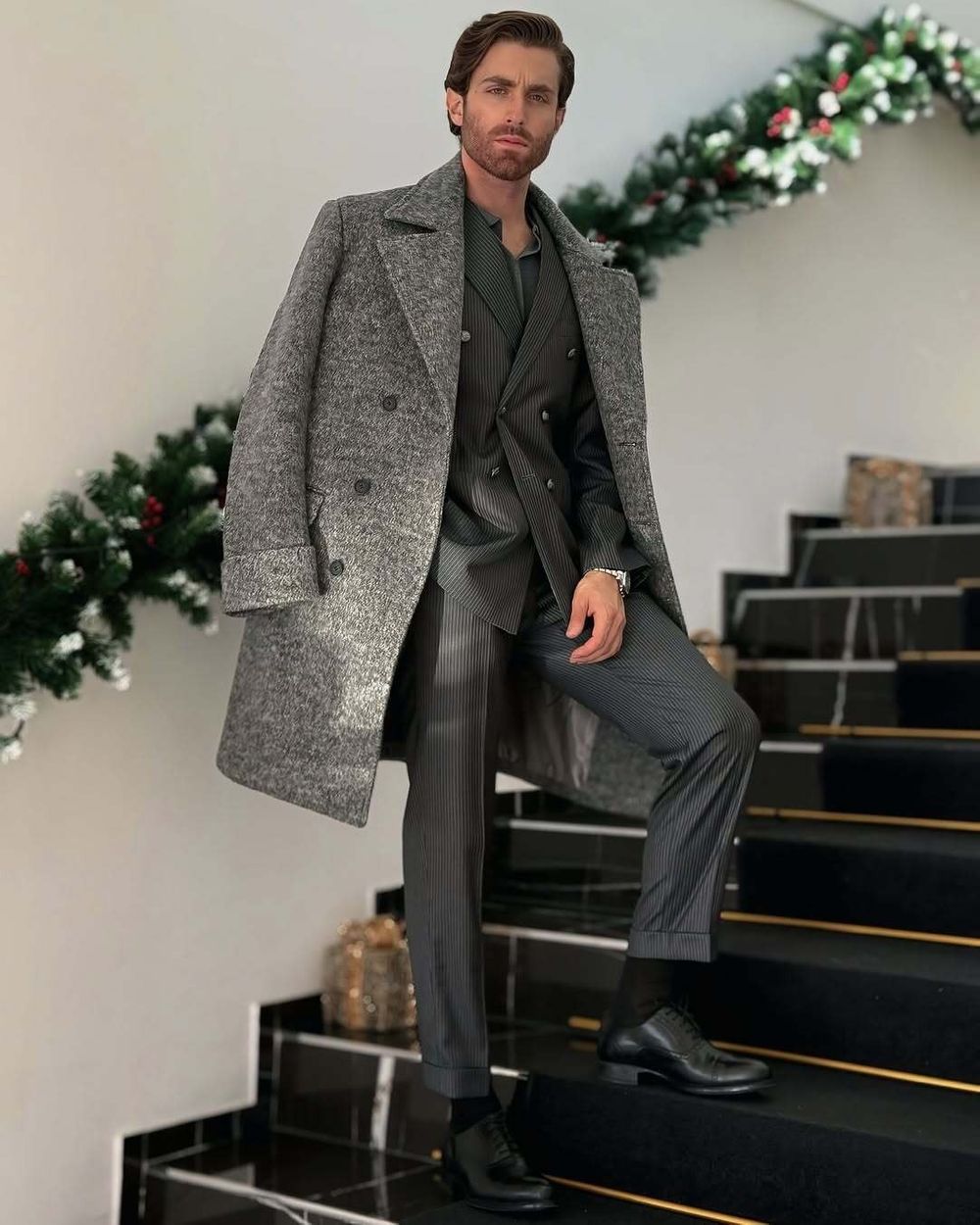
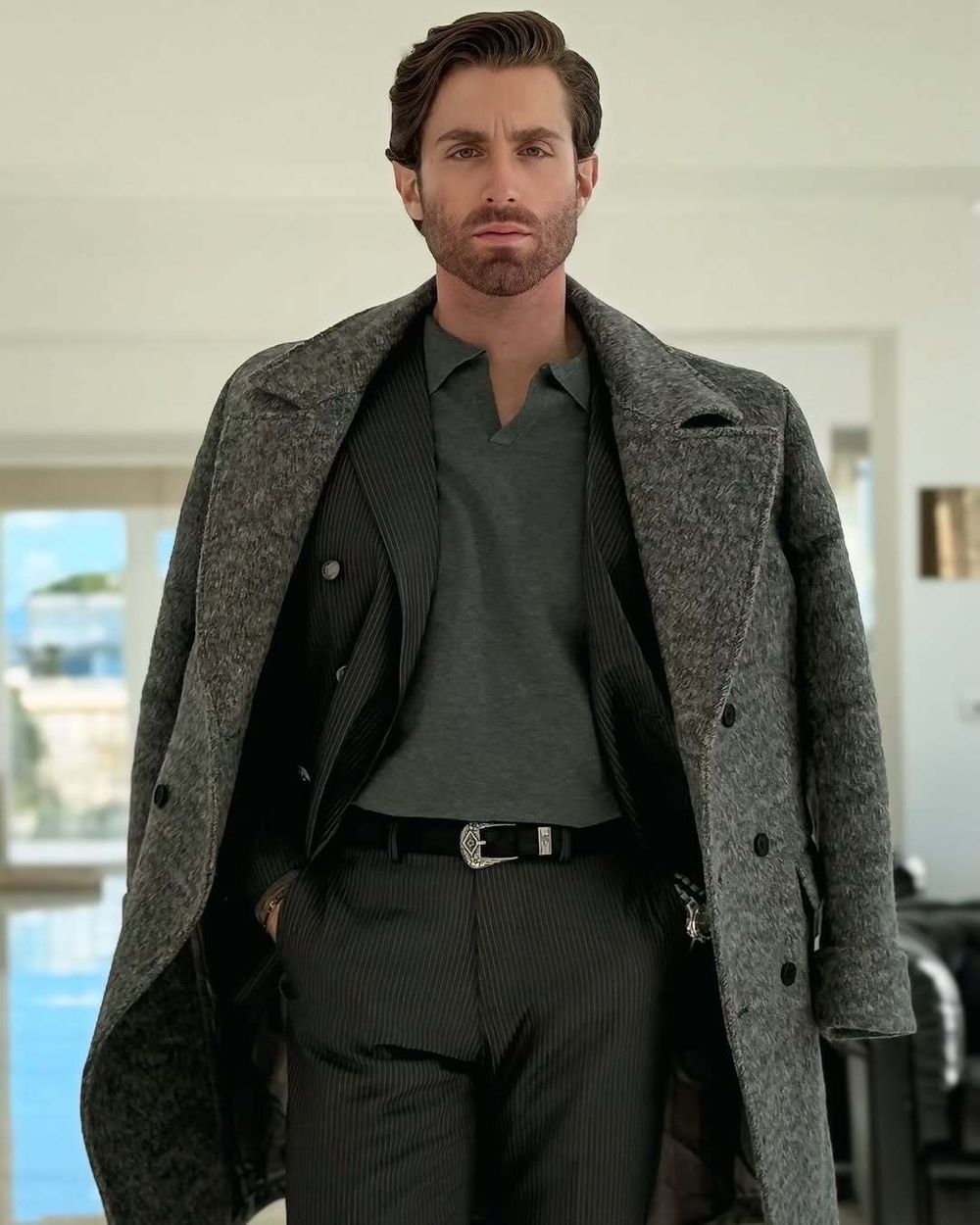

Why We Should Go For Made-to-Measure Suits
A made-to-measure suit is crafted using your exact body measurements, ensuring a perfect fit for any body type, whether you're tall, broad, athletic, or somewhere in between. Unlike off-the-rack suits, it adapts to your unique proportions and posture for maximum comfort and confidence. Plus, you get to customize every detail: from fabrics, linings, lapels, and buttons to pocket styles and even monograms.
At Hockerty, you can design your made-to-measure suit online in minutes, with no in-person fitting required. Choose from 150+ premium fabrics and endless combinations, then let our expert tailors bring it to life. Delivered straight to your door and backed by our Perfect Fit Guarantee, a Hockerty suit represents your style, your fit, your rules.
Frequently Asked Questions (FAQs)
How many types of suits are there?
There are 31 main types of suits for men, categorized by elements such as jacket styles (single-breasted, double-breasted), fits (slim, modern, regular), lapels (notch, peak, shawl), fabric types (wool, tweed, linen, etc.), vents, pockets, button configurations, and canvas constructions. Additionally, there are special suit styles like tuxedos, morning suits, Nehru suits, and three-piece suits, each designed for specific occasions or cultural preferences.
What 5 suits should you have?
Every well-dressed man’s wardrobe should include these five essential suits:
-
Navy Single-Breasted Wool Suit: Versatile for business, weddings, and interviews.
-
Charcoal Grey Suit: A formal alternative to navy that works year-round.
-
Tuxedo: Ideal for black-tie events and weddings.
-
Lightweight Linen or Cotton Suit: Perfect for summer or outdoor events.
-
Three-Piece Suit: Adds extra formality and layering options for special occasions.
What is the most common type of suit?
The single-breasted, two-button wool suit with a notch lapel is the most common and versatile suit for men. It’s suitable for nearly all settings and pairs well with different shirt and tie combinations. Its timeless design makes it a go-to choice for both first-time suit buyers and seasoned professionals.
What is the main difference between Single-Breasted and Double-Breasted suits?
Single-breasted suits have one set of buttons and a narrow overlap of material, whereas double-breasted suits have a wider overlap and two parallel sets of buttons.
Why are there so many fabric options for suits?
Different fabrics offer varying textures, weights, and appearances. They also influence a suit's comfort, breathability, and suitability for different occasions and climates.
How do I know which fit is right for me?
It depends on your body type and comfort preference. Slim fit is tailored closer to the body, classic fit offers a traditional silhouette, modern fit is a balance between slim and classic, and relaxed fit provides more room.
What determines the type of lapel on a suit?
The lapel style often aligns with the suit's formality level and personal preference. Notch lapels are versatile, peak lapels are more formal, and shawl lapels are typically found on tuxedos.
Why do some suits have vents while others don’t?
Vents aid in movement and drape. The choice between no vent, center vent, or side vents depends on style preference and the desired silhouette.
How does construction affect the quality of a suit?
Bespoke suits are custom-made, offering the best fit. Made-to-measure suits are adjusted based on standard sizes, while off-the-rack suits come in predetermined sizes. Generally, bespoke suits are of the highest quality, followed by made-to-measure, and then off-the-rack.
Is the number of buttons on a suit just a style preference?
Largely, yes. Two-button suits are the most common. The number of buttons can affect the suit's formality and how it elongates the torso.
Why would I choose a special type of suit like a Nehru or Tuxedo?
Special types cater to specific occasions, cultural influences, or style preferences. Tuxedos are for formal events, while a Nehru suit offers a unique cultural touch.
What’s the difference between British, Italian, and American suits?
These styles have regional variations in fit, material, and design. British suits are structured, Italian suits lean towards a slim fit with soft shoulders, and American suits are traditionally more relaxed.
Why are there seasonal variations in suits?
Seasonal variations ensure comfort and appropriateness. Summer suits are lightweight for hot climates, while winter suits are made from heavier fabrics for warmth.
What are the benefits of different pocket styles?
Different pocket styles offer both functionality and aesthetics. Flap pockets are versatile, jetted pockets offer a sleek look, patch pockets add a casual touch, and ticket pockets, once functional for holding train tickets, now add a traditional flair.
What does the canvas in a suit refer to?
The canvas is an inner layer sewn into the jacket's chest, providing structure and shape. A full canvas means the entire front side is canvassed, half canvas covers the chest and lapel, and fused means the suit uses adhesive to attach the fabric to the inner lining.
Why might someone opt for a collarless or Mandarin suit?
The Mandarin suit offers a clean, modern aesthetic. It can be a cultural choice or a fashion statement for those looking for a minimalist appearance without the traditional lapel.
How does the trouser style affect the overall look of the suit?
Flat-front trousers offer a modern, streamlined appearance. In contrast, pleated trousers can add a touch of traditional style and may offer more room for comfort. Cuffs add weight to the trouser hem, affecting drape and formality.
Is there a difference between a travel suit and a regular suit?
Travel suits are designed with frequent travelers in mind, often made with wrinkle-resistant fabrics and sometimes featuring multiple pockets for functionality.
Why is velvet considered a suit fabric, and when is it appropriate to wear?
Velvet, with its luxurious texture and sheen, is reserved for more opulent occasions like evening events or parties. It's less traditional but makes a bold style statement.
Are there rules for matching suit fabrics with seasons?
Traditionally, lighter fabrics like linen are favored in the summer, while heavier wool or flannel suits are preferred in colder months. However, modern fashion often bends these rules for style or comfort.
Why are some suits described by their region, like Italian or British?
Regional designations often refer to the traditional tailoring styles and preferences of that area. For instance, British suits might be more structured with a stiffer construction, while Italian suits emphasize a softer silhouette and lightweight construction.
What occasions call for a morning suit?
Morning suits are traditionally worn for daytime formal events, especially weddings, royal events, or horse racing outings in some cultures.
Is there a difference in maintenance or care between different suit types?
Generally, suits require similar care regardless of type. However, certain fabrics might have specific care instructions. For instance, velvet suits may need special attention to maintain their sheen, while wool suits benefit from occasional brushing.









































































































































